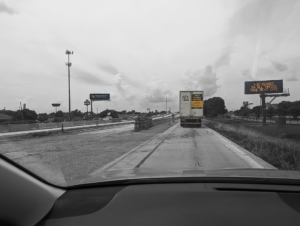No Zones Are Blind Spots for 18-Wheelers. Here’s How to Identify & Avoid Them.
Blind spots are hidden dangers for any vehicle. With tractor-trailers, those blind spots can be like the Bermuda Triangle, hiding multiple cars from truckers’ view and greatly increasing the risks of crashes. No matter where or when you share the roads with big rigs, here’s what you need to know to spot and stay out of trucks’ no zones.
Where Are Trucks’ No Zones?
18-wheelers have four no zones or blind spots. In front, back, and one on each side, these blind spots are all different sizes, as noted in the table below.

Keep in mind that:
- Blind spots move as trucks turn: To complete right-hand turns, truckers generally need to swing out to the left before maneuvering vehicles back to the right. Additionally, the average big rig’s turning radius is about 55 feet. Those factors mean shifting blind spots, creating areas of zero visibility between the truck and curb on the right side. Vehicles and pedestrians who get stuck in these spots can easily get crushed.
- Trucks don’t have rear-view mirrors: With only side mirrors to rely on, truck drivers do not have a way to see what’s directly behind their 18-wheelers. That, coupled with the fact that it takes trucks more time and space to come to a complete stop, are two good reasons to never tailgate tractor-trailers.
- If you can’t see a truck driver, they can’t see you: That’s the best rule of thumb to remember when you’re trying to navigate your way around a big rig’s no zones. If you don’t see truckers directly or in their mirrors, you need to assume that they cannot see you — and you need to get out of that spot safely and quickly to a place where the truck driver can see you.
How to Avoid Truck No Zones: 6 Tips to Stay Out of Blind Spots
Blind spot truck accidents are avoidable if you know how to stay away from trucks’ no zones. Here are a handful of easy ways to minimize your risk of blind spot accidents:
- Look for the truck driver’s face: That’s the only way you’ll be able to figure out if a truck driver can see you or if you’re in a blind spot. Always do you best to move away from the no zones ASAP, which will be any areas where you can’t see a trucker and they can see you.
- Do NOT assume truckers have better visibility than you do: Although big rig drivers sit higher up than other motorists, truckers can not necessarily see more, better, or further than other drivers. In fact, trucks’ large blind spots limit visibility alongside and behind the trailer, with no zones that can hold multiple vehicles.
- Leave at least 4 seconds of following distance when you’re behind a truck: The rule here is to leave about 1 second of distance for every 10 feet of vehicle. With decent weather and road condition, it’s recommended that drivers leave at least 4 seconds of following distance when trailing big rigs. In poor conditions, double that to at least 8 seconds.
- Only pass when you have enough space and time to do so: Don’t attempt to pass 18-wheelers on the left-hand side if you’ll end up being stuck in a no zone.
- Never cut off or cut in front of big rigs: If you’re going to move in front of a tractor-trailer, make sure you leave sufficient following distance between you and the truck. Also, don’t move in front of a truck and then suddenly slow down.
- Use these tips for other big vehicles too: 18-wheelers aren’t the only large vehicles with huge blind spots. Buses, farm vehicles, and other commercial vehicles can have big no zones, just like big rigs. So, be vigilant about staying out of their blind spots too if you’re ever sharing the road with them.









